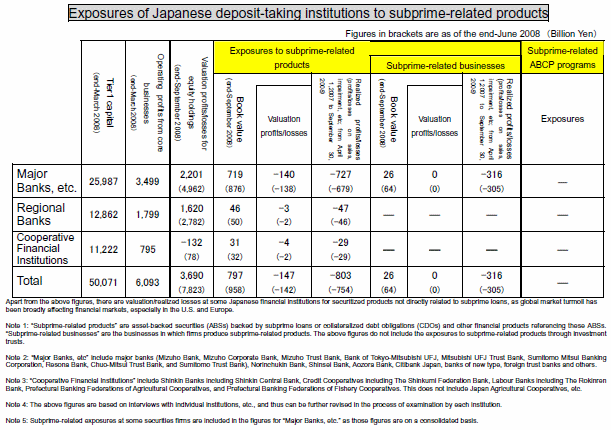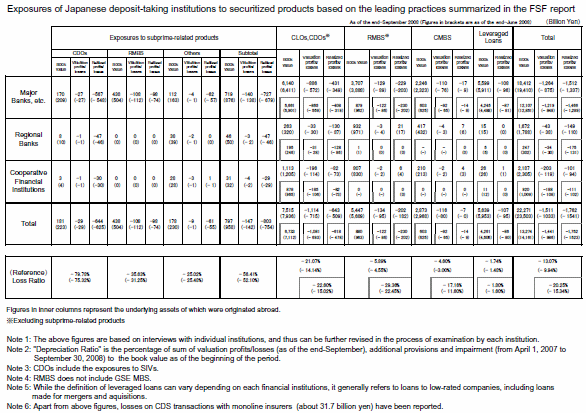 |
 |
Minister Nakagawa inspecting the Tokyo Stock Exchange (December 8) |
Senior Vice Minister Tanimoto delivering a speech at an extraordinary meeting of Local Finance Bureau Directors-General (December 15) |
Photograph Gallery
In this corner, we post photographs of the Minister, the Senior Vice Minister, the Parliamentary Secretary and FSA officials at work in meetings, conferences and other events.
 |
|
At the Tokyo Stock Exchange (December 8)
|
 |
| Parliamentary Secretary Uno delivering a speech at an extraordinary meeting of Local Finance Bureau Directors-General (December 15) |
 |
| Minister Nakagawa delivering a speech at a forum for exchanges of opinions regarding the facilitation of year-end financing (December 17) |
[Featured]
Publication of the Report by the First Subcommittee of the Sectional Committee on Financial System of the Financial System Council: Toward Building Reliable and Vibrant Markets"
On December 17, 2008, the First Subcommittee of the Sectional Committee on Financial System of the Financial System Council (chaired by Kazuhito Ikeo, Professor, Faculty of Economics, Keio University) adopted the “Report by the First Subcommittee of the Sectional Committee on Financial System of the Financial System Council: Toward Building Reliable and Vibrant Markets."
Beginning in October 2008, the First Subcommittee held five sessions of deliberations on ways to build market infrastructures that are fair and transparent and provide a high level of diversity and convenience. In the deliberations, the Subcommittee focused on the following issues from the standpoint of strengthening the competitiveness of Japan's financial and capital markets, while giving due consideration to the global market turmoil caused by the U.S. subprime mortgage problem:
(i) A framework for regulation of credit rating agencies;
(ii) Alliances among financial instruments and commodity exchanges; and
(iii) Review of the disclosure systems.
As for the review of the disclosure systems, the Disclosure Working Group set up under the Subcommittee held deliberations from the experts' viewpoints.
This report summarizes the outcome of the deliberations held by the First Subcommittee.
In light of the contents of this report, the Financial Services Agency (FSA) will quickly start establishing and improving related frameworks and systems.
«Outline of Report»
(1) Framework of regulation of credit rating agencies
In light of the importance of credit rating agencies as elements of the information infrastructure of the financial and capital markets as well as responses to the various problems pointed out regarding them and international developments toward introducing and strengthening regulation of them, it is necessary to introduce regulation on credit rating agencies.
(i) Volume of purchase per day. The upper limit is 25 percent of average daily trading volume during the four weeks immediately preceding the purchase.
(ii) Timing of purchase. Purchase during the 30 minutes immediately before the close of trading is prohibited.
ΟFrom the viewpoint of ensuring the independence of credit rating, the prevention of conflicts of interest, the quality of, and fairness in, the rating process and transparency for market participants, such as investors, it will be appropriate to introduce a new framework of regulation as follows:
* To require registered credit rating agencies to (i) perform the duty of good faith, (ii) disclose information regarding their rating policies and (iii) establish control systems regarding the prevention of conflicts of interest and to (iv) prohibit them from assigning ratings in cases where they own securities issued by the rated entity.
* To impose restrictions on the solicitation of customers by financial instruments business operators using credit ratings assigned by unregistered rating agencies.
* To empower supervisors to require credit rating agencies to submit reports, conduct onsite inspections on their offices and order them to improve their business operations.
(2) Alliances among Financial Instruments Exchanges and Commodity Exchanges
ΟIn order to enable the mutual trading of products between financial instruments and commodity exchanges under the current framework of regulation which subjects financial products and transactions to the Financial Instruments and Exchange Act and commodity derivative transactions to the Commodity Exchange Act, the government must quickly work out specific plans.
ΟThe plans should reflect the following basic concepts:
* To allow flexible options for alliances, such as forming alliances directly between exchanges themselves or through a subsidiary or a holding company.
* To streamline regulation and supervision by eliminating overlapping regulatory and supervisory processes while properly ensuring that the purposes of both acts are observed.
* To strengthen cooperation between the regulators of financial instruments and commodity products in dealing with inappropriate transactions that concern both financial instruments and commodity product markets.
(3) Review of disclosure system
In light of practical processes of securities transactions as well as the needs of investors and issuers, it will be appropriate to implement the following measures in order to ensure that investment information is made easily available to investors when they need it:
* To revise the credit rating requirements, which constitute the eligibility requirements for the use of the shelf registration system, and reform the shelf registration system so as to improve convenience for users.
* To improve the mandatory prospectus regarding investment trust securities so as to provide investors with easy-to-understand, concise information important for investment decisions and simplify the procedures for the electronic provision of the prospectus.
* Regarding the concept of the secondary distribution, to remove the requirement for the “uniform conditions” in light of the increasingly cross-border, complex and diverse nature of securities transactions and make regulation of the provision of information more flexible in light of the practical work processes involved in such transactions.
(4) Other issues
With respect to the procedures for changing from the status of professional investor to the status of non-professional investor under the Financial Instruments and Exchange Act, it is appropriate to consider reforming the current rules so as to keep a change of status in effect indefinitely once the change is made unless the customer applies for a change of status again.
For further details, please access “Report by the First Subcommittee of the Sectional Committee on Financial System of the Financial System Council: Toward Building Reliable and Vibrant Markets" (December 17, 2008) in the “Press Releases” section on the FSA’s web site.
 |
| Minister Nakagawa receiving the First Subcommittee’s report from Subcommittee Chairman Ikeo (December 17) |
Publication of the Report by the Joint Group of the First and Second Subcommittees on Financial System of the Financial System Council
The joint group of the First Subcommittee (chaired by Kazuhito Ikeo, Professor, Faculty of Economics, Keio University) and Second Subcommittee (chaired by Shinsaku Iwahara, Professor, University of Tokyo Graduate Schools for Law and Politics) on Financial System of the Financial System Council have held three sessions of deliberations on the alternative dispute resolution system in the financial sector (financial ADR) since November 2008.
Based on the deliberations, the joint group adopted and published “How the Alternative Dispute Resolution System in the Financial Sector Should Be Operated” on December 17, 2008.
This report suggests that it is desirable to establish a legal framework for the financial ADR that is fair, neutral and effective from the viewpoint of enhancing users’ trust in and satisfaction with the settlement of complaints and disputes and increasing their confidence in financial products and services.
Based on this report, the Financial Services Agency (FSA) will consider necessary measures to establish a desirable financial ADR system.
Key points of the report
* The establishment of a cross-sectoral, comprehensive financial ADR body should be considered as a long-term task. For the time being, voluntary efforts of industry organizations, self-regulatory bodies and other relevant entities toward the settlement of complaints and disputes should be utilized.
* It is appropriate to ensure the neutrality and fairness of financial ADR bodies through the confirmation (designation) by a administrative agency of the framework for the implementation of the financial ADR and persons capable of implementing it.
* It is necessary to consider the practicalities of establishing a common contact point that refers complaints and disputes to relevant financial ADR bodies, in addition to strengthening cooperation between the bodies.
* In the case that a financial ADR body already exists for a financial industry segment, it would be appropriate to obligate financial institutions in that segment to accept procedures regarding the financial ADR body, provide relevant explanations and documents to the body and respect its findings.
* In the case that a financial industry segment lacks a financial ADR body, it would be appropriate to impose some obligations on financial institutions in that segment regarding the settlement of complaints and disputes.
* In order to ensure the neutrality, fairness and effectiveness of the financial ADR, it is necessary that a administrative agency is given some authority over financial institutions and financial ADR bodies with regard to the settlement of complaints and disputes.
* In order to establish an effective financial ADR system, it is necessary to fully take into consideration the contents of financial products and services, the characteristics of inquiries and complaints, the circumstances of users, the number of financial institutions in each financial industry segment and the state of efforts toward the settlement of complaints and disputes in each segment.
* It is necessary for the Financial Service Dispute Resolution Liaison Group to continue to play an important role as the leader of efforts to promote the improvement and development of the financial ADR.
[TOPICS]
Following the announcements by major banks, etc. of their financial results as of end- September 2008, the FSA aggregated the figures announced by these banks and released them on January 9, 2009.
Below is a summary of the financial results of the major banks, etc. as of end-September 2008.
1. Profit status
The net core business profits of major banks, etc. (profits from core banking operations) totaled 1.4 trillion yen in the first half of FY2008 that ended on September 30, 2008, down 0.2 trillion yen compared with September 30, 2007. Although the profit margins and the balance of outstanding loans increased, the increases were limited. Meanwhile, fee revenues declined due to the deterioration of market conditions and expenses grew, including due to a reinforcement of human resources and system investment. A combination of these factors apparently reduced their net core business profits.
The banks’ net profits in the first half of FY2008 that ended on September 2008, totaled 0.3 trillion yen, down 0.5 trillion yen compared with September 30, 2007. In addition to the factors above, the write-downs of stock holdings and credit-related expenses grew, apparently leading to a decrease in net profits.
2. Status of non-performing loans
The non-performing loan ratio of major banks, etc. remained low at 1.5% in the first half of FY 2008 that ended on September 30, 2008, a slight increase of 0.1 percentage points compared with the level at the end FY2007 that ended on March 31, 2008.
Their capital adequacy ratio stood at 12.3% in the first half of FY2008 that ended on September 30, 2008, down 0.6 percentage points compared with the level at the end of FY2007 that ended on March 31, 2008.
Following the announcement by regional banks of the financial results as of end-September 2008, the FSA aggregated the figures announced by these banks and released the results on December 8, 2008.
The following is a summary of the financial results of the regional banks as of end- September 2008.
1. Profit Status
The regional banks’ net core business profits (profits from core banking operations) in the first half of FY2008 that ended on September 30, 2008, declined 24.0% compared with the same period of last year due to an increase in the write-offs of losses on securities holdings and a decrease in fee revenues.
Their net profit dropped 62.8% due to increases in the cost of the disposal of nonperforming loans and the cost of writing off losses on shareholdings, in addition to the decline in the net core business profits.
2. Status of Non-Performing Loans
The amount of non-performing loans held by the regional banks increased compared with the level at the end of the fiscal year that ended on March 31, 2008, with the non-performing loan ratio rising slightly.
3. Capital Adequacy Ratio
The average capital adequacy ratio of the regional banks (excluding Ashikaga Bank) declined slightly compared with the level at the end of the fiscal year that ended on March 31, 2008.
Key Points of Regional Banks’ FY2008 Interim Financial Results
1.Profit Status
ΟRegional banks’ net core business profits (profits from core banking operations) in the first half that ended on September 30, 2008 (FY 2008 midterm) declined 24.0% compared with the same period of the previous year due to an increase in the cost of writing off losses on bond holdings and a decrease in fee revenues.
ΟTheir net profits dropped 62.8% due to increases in the cost of the disposal of nonperforming loans (NPL) and the cost of impairment losses on shareholdings, in addition to the decline in net core business profits.
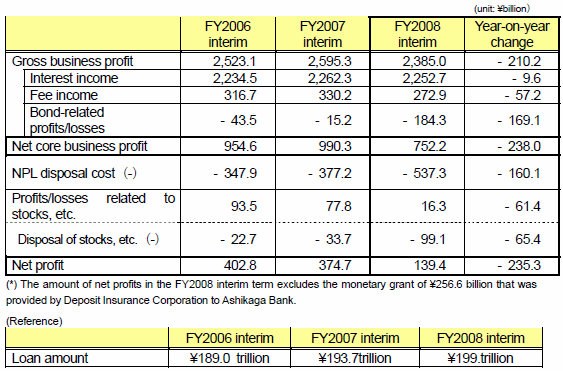 |
2.Status of Non-Performing Loans
ΟThe amount of non-performing loans (NPLs) held by regional banks increased compared with the level at the end of the fiscal year that ended on March 31, 2008 (FY2007), with the non-performing loan ratio rising slightly.
 |
(Note) The NPL amount peaked at ¥15 trillion in the FY2002 midterm, with the NPL ratio peaking at 8.3% in the same term.
3.Capital Adequacy Ratio
ΟThe average capital adequacy ratio of regional banks (excluding Ashikaga Bank) declined slightly compared with the level at the end of the fiscal year that ended on March 31, 2008 (FY2007).
 |
(*) The figures in the parentheses exclude those for Ashikaga Bank, which was under special public management.
(Note 1) The number of banks covered by the figures for the FY2007 midterm, the FY 2007 full term and the FY2008 midterm stood at 110 (including 64 regional banks, 45 second-tier regional banks and Saitama Resona Bank).
The number of banks covered by the figures for the FY2006 full term stood at 111 (including 64 regional banks, 46 second-tier regional banks and Saitama Resona Bank)
The number of banks covered by the figures for the FY2005 full term and the FY2006 midterm stood at 112 (including 64 regional banks, 47 second-tier regional banks and Saitama Resona Bank).
(Note 2) The above figures were calculated on a non-consolidated basis. However, the figures for nonperforming loans include those of subsidiaries specialized in business rehabilitation.
(Note 3) The figures for the FY2007 midterm and the 2006 midterm are different from those published by the Financial Services Agency in the past because some banks revised their financial results.
Exposures of Japanese deposit-taking institutions to subprime-related products and securitized products
On November 28, 2008, the Financial Services Agency (FSA) published the exposures of Japanese deposit-taking financial institutions to subprime-related products and securitized products based on the leading practices summarized in the FSF report as of the end of September 2008.
Subprime-related products held by Japanese deposit-taking financial institutions as of the end of September 2008 totaled ¥797.0 billion (down ¥161.0 billion compared with the end of June 2008), while the total of their valuation and realized losses on such products amounted to ¥950.0 billion (¥896.0 billion as of the end of June 2008).
Meanwhile, securitized products held by Japanese deposit-taking financial institutions totaled ¥22,271.0 billion (down ¥1,232.0 billion compared with the end of June 2008), while the total of their valuation and realized losses on such products increased sharply, to ¥3,273.0 billion ( ¥2,574.0 billion as of the end of June 2008).
One probable reason for this is that after the summer of 2007 an increase in losses was mainly on subprime-related products, afterwards the impact of the subprime mortgage problem spread to the entire market for securitized products, leading to an increase in losses on securitized products not related to subprime mortgages, such as collateralized debt obligations (CDOs), collateralized loan obligations (CLOs), residential mortgage-backed securities (RMBS) and commercial mortgage-backed securities (CMBS).
Since September 2008, the FSA has published the exposures of Japanese deposit-taking financial institutions to subprime-related products and securitized products(*) under unified standards.
We believe that efforts like this help promote a precise understanding of the impact of the turmoil in the global financial markets on Japan’s financial system.
The FSA will promote the dissemination of information and continue to improve the public access to the current state of the Japanese financial system and the concept of our financial regulation.
(*) As for exposures to securitization products based on the leading practices summarized in the FSF report, the FSA started data compilation and publication with the exposures as of the end of March 2008.
* For further details, please access “Exposures of Japanese deposit-taking institutions to subprime-related products and securitized products based on the leading practices summarized in the FSF report” (November 28, 2008) in the “Press Releases” section of the FSA’s web site.
The Financial Services Agency (FSA) published data on the distribution of rating grades assigned under the Financial Inspection Rating System on December 16, 2008.
1. The FSA started applying the Financial Inspection Rating System on a trial basis in January 2006 and put it into force in April 2007 (The application to financial institutions other than major banks started in January 2008).
2. The purpose of the Financial Inspection Rating System is to assign grades (Note 1) to the results of inspections, thereby motivating financial institutions to make management improvement on a voluntary basis and increasing the efficiency and effectiveness of inspections at the same time.
3. In light of this purpose, we believe that it is sufficient that each of the inspected financial institutions are aware of specific rating grades assigned to itself and that it would not be appropriate to publicly disclose the specific rating grades assigned to individual financial institutions because such disclosure could cause reputational risk for them.
4. However, in response to requests for the disclosure of the distribution of rating grades assigned under this system, the FSA disclosed twice in the past the distribution of Grades “C” and “D” (“A” is the highest grade and “D” is the lowest) by type of financial institution.
5. This time, regarding inspections notified and conducted between April 2007, the first month after the period covered by the previous disclosure (Note 2), and the end of June 2008, which marked the end of Program Year 2007, we disclosed the distribution of Grades “A” and “B” in addition to Grades “C” and “D” (the number of financial institutions covered by this disclosure totaled 314).
6. The FSA will continue to accumulate data on the distribution of rating grades assigned under the Financial Inspection System and consider disclosing the data when it has accumulated a certain volume.
(Note 1)
Grade A: A strong management system has been established by the management
Grade B: A sufficient management system has been established by the management
Grade C: The management system is insufficient and needs to be improved.
Grade D: The management system is defective or seriously defective.
(Note 2) The previous disclosure was made on December 11, 2007 (covering the results of inspections conducted during the trial application period of this system, which started in January 2006 and expired at the end of March 2007, when the Financial Inspection Manual was revised).
1.Financial institutions subjected to the Financial Inspection Rating System
Under the Financial Inspection Rating System, 314 financial institutions were subject to inspections which started between April 2007 and the end of June 2008 (Note 1). (The number of rated items totaled 2,901.)
(Note 1) Prior notice for these inspections was made between April 2007 and June 2008. (Unannounced inspections were conducted during this period.)
2.Distribution of grades by sector (number of rated items/total number of rated items for each sector)
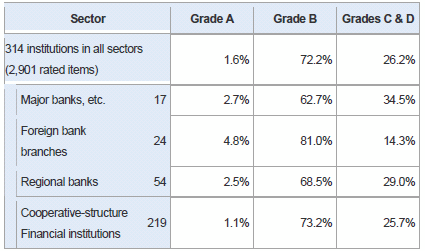 |
(Note 2) The total of the percentage figures for “Grade A”, “Grade B” and Grades C & D may not necessarily add up to 100% due to rounding. The same shall apply to “3. Distribution of grades by rated item.”
3.Distribution of grades by rated item(number of rated items/total number of rated items for each system)
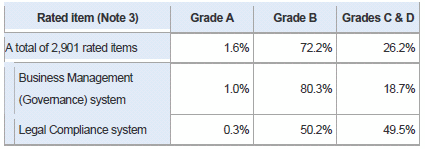 |
 |
(Note 3) Following the revision of the Financial Inspection Manual, the number and composition of rated items was changed. (The number was changed from 9 to 10.)
Site Map
- Press Releases & Public RelationsPage list Open
- Press Releases
- Press Conferences
- Official Statements
- FSA Weekly Review & ACCESS FSA
- Speeches
- For Financial Users
- Others
- Archives
- Laws & RegulationsPage list Open
- Name of Laws and Regulations(PDF)

- Recent Changes (Legislation, Ordinances, Guidelines)
- Guidelines
- Financial Instruments and Exchange Act
- Financial Monitoring Policy
- Public Comment
- No-Action Letter System
- Procedures concerning Foreign Account Management Institutions









